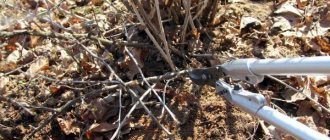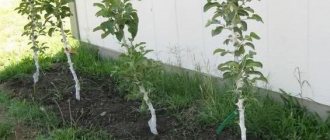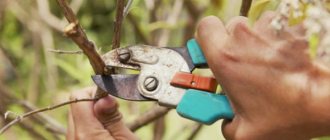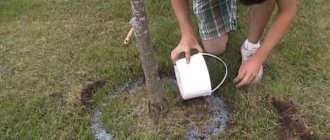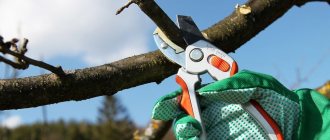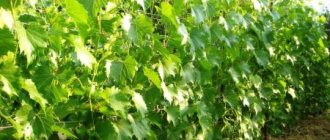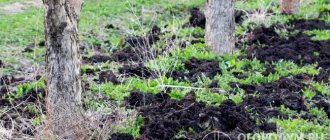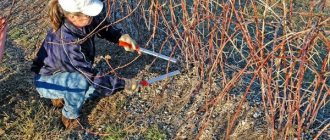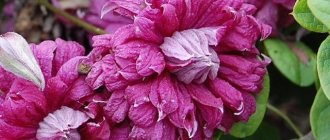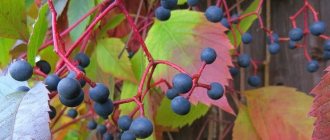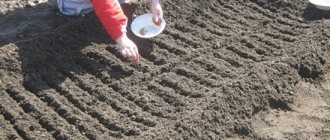The right type of apple tree
It's never too late to learn how to care for an old apple tree. Even a dilapidated tree can be revived by methodical, consistent pruning of its branches. This procedure must be done correctly. To understand how to rejuvenate a garden plant, you should consider the ideal appearance of an apple tree.
How to rejuvenate an old apple tree: rules and pruning patterns. How to rejuvenate an old apple tree: pruning scheme, feeding. How to care for an old apple tree
In the absence of timely pruning, the tree has a dense crown. Skeleton-forming branches grow chaotically, they have no specific order. The shoots can cross significantly, blocking the light of their neighbors. Such branches often damage each other in strong winds.
With proper care, the tree is distinguished by the presence of a central leading shoot. It forms a trunk from which the branches of the skeleton extend. The barrel is pointed straight up. The branches that extend from it do not have an acute angle relative to it. The upper shoots should be shorter than the lower ones. This is what an ideal apple tree should look like. This form is created over several years. The branches do not interfere with each other. They transmit maximum light to subsequent shoots.
When deciding to rejuvenate an apple tree that is fairly overgrown, you should strive to give it exactly this shape. This process will take quite a lot of time. The correct direction and density of the crown can be restored in approximately 3 years. At this time, periodic methodical pruning will be required. Deep and rapid removal of excess branches can kill the tree. It is for this reason that the procedure is carried out carefully and takes a lot of time.
What to do with an old apple tree in spring: diagram
The spring formation of apple trees is carried out before the buds swell. The branches above the bud are shortened, the cut is made obliquely, the upper side is at the same level as the bud. For proper crown formation, the upper branches should be shorter than the lower and middle ones.
At the same time, in the spring, those shoots that are frozen are removed.
Warning! A heavily frozen apple tree is pruned a month later to understand the extent of the damage and to easily distinguish healthy branches.
The length of the shoots left depends on the growth rate of the tree:
- in short and dwarf plants, only the tip of the shoot needs to be removed;
- in apple trees of medium growth, the shoots are shortened by a third;
- for vigorous apple trees - half.
All cuts are processed in the same way as in the fall.
All the details of pruning and shaping old apple trees in the spring are on video:
Trimming tools
It is impossible to rejuvenate an old apple tree without special tools. All of them must meet standard gardening requirements so as not to harm the tree by destroying it. Armed with the right tools, even a person with no experience can remove excess branches from an old plant. When choosing devices, pay attention to:
- Handle material and handle shape. It shouldn't slide. If it is not comfortable to hold, the instrument may fall out of your hand at the most crucial moment.
- Weight. The larger it is, the more tired your hands will be during work. Secateurs that are too light will be difficult to hold.
- Blade outline. It should taper towards the outer end. This way you can reach even hard-to-reach branches.
- Strength. No part of the instrument should bend or appear fragile. During the procedure, strong pressure will be applied to all items used, which is why poor-quality material or assembly will lead to failure of the device.
- Blade sharpness. Dull pruning shears and a knife will not make neat cuts. The recovery time depends on the degree of damage. Large damage to wood, especially during shock rejuvenation, can lead to the death of the apple tree.
First you need to choose a pruner. It can be difficult for a novice gardener to choose the right tool due to the variety of types. Immediately avoid purchasing miniature items made specifically for florists. They are sharp, but are not intended for cutting thick branches. Flower pruners are also not suitable. Choose large or medium sized multipurpose tools. They can even cope with old apple tree shoots.
We must not forget about safety. To avoid getting hurt or catching a splinter, use gloves. They must be made of dense material, otherwise one set will not be enough to carry out the entire procedure. When purchasing gloves, check that there is no feeling of tightness anywhere. This can cause your hands to go numb: this is doubly dangerous when working with sharp objects.
You can use pruning shears to trim knots, but experienced gardeners recommend purchasing a special tool. It will be needed to remove shoots with a diameter of 30 to 50 cm. Due to their miniature size, they are easier to cut off branches located in the thick of the crown. This makes the process of rejuvenating an old apple tree easier: by removing thin shoots, you can get to thicker shoots without extra effort.
Attention! All tools must fit comfortably in your hand and not cause discomfort.
When is the best time to prune an old apple tree?
The need for periodic rejuvenating procedures is undeniable, but it is important to adhere to certain pruning nuances so as not to disrupt the vital processes of the plant:
- Pruning should be carried out in several stages so as not to seriously injure the tree.
- The most favorable time for pruning is when sap flow stops or slows down (spring and autumn).
- The rejuvenating procedure is carried out in the fall for old and large apple trees.
Important! Remember that regardless of the period, it is important to prune when the sap flow is slow.
In the spring, you need to have time to prune before the buds open, in the fall - after the natural fall of leaves and fruits. It is not possible to determine the exact date, since in each specific case one must be guided by the weather conditions of the area. It is also important to consider how old the tree you want to renew.
Video: How to properly prune an apple tree in the fall
in spring
The spring renewal method is perfect for removing branches that have frozen over the winter. Remember that the process must begin even before sap flow and bud formation begin.
For the territory located in the middle zone, this time begins approximately in the second half of March . Adherents of this method claim that the crown is best visible in the spring. In addition, after pruning, the tree will have enough time to recover.
When pruning, avoid the so-called skeletal branches (the longest ones that come straight from the trunk) as they take the longest to regenerate. Experts also advise carrying out root rejuvenation procedures in the spring.
Timing of pruning
A lot depends on the correct choice of deadline; if the work is done on time, the stress on the tree will be minimal. Summer pruning is allowed to be carried out in early June; if done later, high air temperatures will negatively affect the health of the seedling. In the early stages of planting, plants need careful care, this includes abundant and timely watering. By autumn, the crown of apple trees will be perfectly formed, even the color and structure of the foliage will change. The procedure will have a positive effect on the bark, which will not have cracks and will become smoother. On the apple tree, after summer pruning, carried out according to all the rules, the number of flowers will significantly increase, which will have a good effect on the harvest.
Many people prefer to rejuvenate apple trees shortly before the sap begins to flow. If an old tree is pruned in the spring, it will be able to heal its wounds during the warm season. Before the cold weather it will restore its new shape. If this work has to be left until autumn, then you need to wait for the fruits, remove them and wait until the leaves fly off. The apple tree will be at rest before the onset of cold weather; as a result, injuries will not greatly affect its condition. You can rejuvenate an apple tree in the fall once every 5 years. In this case, the central conductor is cut down to a height of no more than 4 m, young shoots, branches growing in the middle of the crown, skeletal branches and those that suppress those growing nearby are cut off. All tops and shoots are removed from the trunk. Very long young shoots are made one third shorter.
Apple tree rejuvenation pruning scheme
Before you begin anti-aging pruning of an apple tree, make sure that the tree is strong enough to bear it. If the main trunk has already begun to dry out or rot, is covered with hollows, and has a wide crack, then it is not worth wasting energy on this tree; it is easier to cut it down and plant a young apple tree in the garden as a replacement.
Currently, there are three main schemes for anti-aging pruning of apple trees: gradual, half and one-time.
Gradual
An old apple tree should be properly pruned over a period of 2-3 years in several stages. All excess branches and twigs are gradually removed from the tree. At one time, no more than 30% of the total number of branches is removed. Otherwise, the likelihood of the apple tree dying increases. Each year the work is divided into seasons.
Second year
Rejuvenation of an old apple tree, as mentioned above, is carried out in several stages. After the first autumn pruning, it is necessary to carry out a series of procedures next spring. New vigorous shoots may appear at the top. They will need to be partially removed. There should be one such shoot on each strong branch.
After such pruning, proportionate branches will remain on the tree. Young shoots will develop on them. This is where the fruits will subsequently form. Medium-sized shoots are pulled down using steel wire. They should take as horizontal a position as possible. It is very important not to overdo it. Too much force can damage the branch.
When the presented procedure is completed, you need to trim the remaining new shoots using the “ring” method. This part of the shoot is also called the “collar”. It is located at the base of the branch. At this point it connects to the trunk. The bark on the “collar” has a wrinkled structure. This part contains cells that promote healing of shoot wounds. Therefore, the “ring” cut is made above this “collar”.
In the second year, several procedures will also need to be performed in anticipation of winter. If you need to reduce the height of the tree, cut off another 1/3 of the original level. Some skeletal branches are cut off. This should provide the lower branches with enough light.
Year three. Spring Summer.
The third summer will “allow” to cut off the second half of the growing “tops” . The wire is removed from the previously “bent” ones. Are there any candidates for fruit branches among the new tops? They are bent in a similar way for the fastest transition into fruit branches.
Sanitary pruning
Knowing how to rejuvenate an old apple tree, you need to consider another type of pruning. It's called sanitary. In this case, remove all branches that could potentially pose a danger to the tree. This procedure is carried out without fail after outbreaks of diseases on garden plants or after natural disasters.
This type of pruning will require the removal of all dead, infected or damaged shoots. Even if there are a lot of them, you will need to cut them all off. Otherwise, the tree will not have a chance to survive. Such deep pruning is carried out for both old and young apple trees.
During this procedure, the branches are removed right under the ring. If the shoot has been infected, you need to also capture some of the healthy tissue when pruning. This way you can prevent the development of rotting. Thin broken branches are removed using pruners.
This deep pruning may be necessary after a very cold winter. Frozen shoots are cut down to living tissue. All cut shoots must be burned to ashes.
First autumn pruning
The rejuvenating procedure begins with pruning old apple trees in the fall. For beginner gardeners, it is necessary to review the detailed procedure for this process. It is necessary to remove dry, disease-damaged shoots. The branches are cut to the ground. The remaining stump can cause an infection.
Gradually you need to prune large branches. You need to follow the leading trunk. If the apple tree has sprouted several new central shoots, they must be inspected visually. If one of the new leaders is healthier and stronger than the old one, he is left. Then the old central trunk is removed.
You need to remember that no more than 3 large branches can be cut in one year. This will prevent the tree from becoming too stressed. It will be more difficult to make a mistake in this case.
Next, the scheme for pruning apple trees in the fall involves determining the optimal height of the tree. A level of about 4 m is considered optimal. If the plant reaches 6 m, it becomes difficult to prune and protect it from harmful insects and infections. If you need to shorten the crown by 1 m so that the total size is 5 m, you can trim only 30-35 cm in the first year.
The crown will also need to be thinned. All thin, dry, dead branches are removed. Each shoot is carefully examined for the presence of infections. Affected branches must be cut off.
Half
This method is practiced by experienced gardeners. It allows you to quickly and without harm to the fruit tree free the crown from unnecessary branches. Work on crown formation is carried out over two years in several stages. To renew the apple tree, in the first year it is shortened to a height of 3 m. On the south side, the crown is cut to a width of 2 m. The next year, the rest of the tree is formed in the same way.
The most developed tops are left on all branches at intervals of 70 cm from each other. The cuts are cleaned with a knife and covered with oil paint. If the width of the cut exceeds 5 cm, it is additionally covered with black polyethylene. The shelter is removed only with the onset of autumn.
Disposable
This method is also called maximum or shock pruning. This type of cutting greatly weakens the tree. Therefore it may die. One-time pruning is used only as a last resort, but it is not advisable to use it if it is necessary to remove more than half of the branches. To do this, you need to shorten the tree to the desired height by cutting off the top of the central conductor. After this, all damaged, infected, non-fruiting shoots are removed.
Important! One-time pruning is allowed only in spring. If you cut the branches of a plant in the fall in this way, it will die in the winter.
How to properly trim apple tree branches - basic requirements
So, we figured out what needs to be deleted and what to leave. Now it is important not to forget exactly how to remove excess branches on a neglected apple tree and how to process the cut points.
First, prepare all the necessary tools and try to think through a system of lifts and fastenings that will allow you to get to the top of the crown. If the apple tree you are pruning is no taller than 5 m, then a stepladder will be enough, but on larger trees you will need both a ladder and a lopper with long handles. If possible, attach the main tool to your belt or have an assistant hand it to you as needed.
Immediately take garden varnish or an analogue of this substance to treat saw cuts and cut areas - if you leave it for later, you may miss some wounds and worsen the condition of the tree.
Having trouble knowing what to trim and what to leave? Then watch the video of pruning an old apple tree, it is more clear.
If all rules and deadlines are followed, even an old tree can extend its life and fruit production. Of course, pruning apple trees for beginners is not an easy task, but with due effort you can cope with it.
How to renew an apple tree by pruning fruit branches?
The most valuable branch is the fruit . Apple trees bear fruit on short fruit-bearing branches, which are formed from branches two years old.
Anti-aging pruning is used to achieve the appearance of new fruits. Even though the old fruit shoots are capable of bearing fruit for some time, in order for the tree to maintain fruit bearing, new fruit shoots must continue to form.
The formation of fruitlets begins with the removal of the apical buds on annual branches. In the first year, lateral twigs develop. In the second year, flowers develop on the side shoots, becoming the tree's new fruiting site.
Subsequently, such fruit twigs become overgrown with short branches with only flower buds. These are already fruits. After 5 years, they become heavily overgrown and bear little fruit. And they will need to be cleaned. After 7 years, such fruit links are completely removed, transferring to a new replacement shoot.
Other methods
How to prune an old, very tall apple tree
In this case, the main actions of the gardener remain pruning excess shoots and reducing the crown of old apple trees.
Tall and old apple trees are distinguished by the presence of a bare center, which is formed due to lack of lighting. Therefore, at the first stage of rejuvenation of this type of tree, a procedure is carried out to reduce the height by at least a third. This causes the growth of new branches and improves light access throughout the entire diameter of the crown. In this case, you should adhere to certain rules:
- In one year, no more than two large branches are removed at a time. Large ones include shoots 10 cm thick.
- Small shoots are cut under the bud.
- Young shoots are left for the next pruning, the rest are removed to a side bud for vertical growth.
- Be sure to cut off the branches and ensure that the branches are subordinated to each other.
In addition, all branches that have lost their ability to grow must be removed. The cuts are made at an angle of 45°.
How to rejuvenate an old apple tree: rules and pruning patterns. How to rejuvenate an old apple tree: pruning scheme, feeding. How to care for an old apple tree
Shock pruning for rejuvenation of old apple trees
This method is suitable for old neglected apple trees that practically do not bear fruit. Such trees have a spreading crown and reach a height of 12 m. Shock rejuvenating pruning is carried out for plants with a strong central conductor and healthy side shoots. There should be no cracks, lichen or hollows on the trunk.
Important! After shock pruning, the apple tree requires a lot of effort to recover. The crop is susceptible to disease and freezing in winter and may die as a result.
The procedure for shock pruning for apple tree rejuvenation:
- First, sanitization is performed: old and broken branches are removed.
- The central conductor is shortened to a height of 3.5-4 m. 2-3 thin shoots are left under the cut. The top is cut off in several stages so that it does not cause damage if it falls.
- The remaining skeletal shoots are shortened to 2 m. It is advisable to leave fruit-bearing branches at the age of 3-4 years.
- The cut areas are treated with garden varnish.
- In the spring, the trunk is cleaned and whitewashed.
Maximum pruning and when is it needed?
Maximum pruning is carried out only after any climatic disasters. After a hurricane, freezing rain, severe hail, severe drought, extremely cold winter, or fire. Only such drastic incidents give permission for maximum voluminous pruning.
In this case, everything broken and dead is removed to make healthy wood. All other reasons should not push the gardener to radical pruning. From such pruning, especially when carried out by beginners, nothing but harm to the tree can be achieved.
In conditions of such pruning, it is very important
to remove all diseased and damaged branches and twigs , that is, to free the apple tree from unnecessary load.
Gentle
How to rejuvenate an old apple tree: rules and pruning patterns. How to rejuvenate an old apple tree: pruning scheme, feeding. How to care for an old apple tree
This processing method takes a very long time, taking at least five years. Involves eliminating old branches. It is allowed to trim apple tree shoots to a length not exceeding two meters. Annual pruning of thick branches leads to the fact that the tree is constantly in a state of stress, its productivity decreases sharply, and an increase in fruiting of the apple tree can be seen only after 5 years - when the pruning of old branches is completed.
Modern way
This method of pruning old apple trees follows the following scheme:
- Trim off most of the south-facing crown of the tree. Leave a sector about 3 meters high and 2 meters wide.
- Limited to a minimum number of cuts.
- All cuts are lubricated with garden varnish to avoid chapping of exposed areas, evaporation of nutritious juice, and also to protect them from infections.
- Simultaneously with crown rejuvenation, this method involves rejuvenation of the plant’s root system. To do this, cut off all the roots of the tree, which are found at a depth of up to 70 cm in an area about 4 cm wide. Cutting out the roots should be done from the side of the trimmed crown.
- A few years later (after the yield has been restored on the southern side of the crown), the above-ground part of the tree oriented to the north is pruned according to a similar pattern.
Spring and autumn schemes
If the tree is not neglected, it does not have pronounced problems, but the fruits have become smaller, they have lost their original taste characteristics, seasonal rejuvenation can be carried out. The pruning pattern will depend on the time of year. In spring, it is undesirable not to touch the main central branches, especially if sap flow will soon begin. It is important to remove too high shoots, side shoots, and so-called competitors. It is important to leave the central part of the tree with the strongest formations that are capable of bearing fruit this season.
Note! After the buds open, you need to conduct an additional examination, then remove everything that has frozen.
In autumn, more radical rejuvenation is permissible. During this period, you need to remove all those branches that have the wrong direction of growth. All side growth that has formed over the summer is also cut out. Leave 1-2 side branches as main branches for the next season.
Apple trees require special attention. They quickly grow side shoots, which not only spoil the appearance of the crown, but also prevent the plant from devoting all its efforts to forming a mass of crops. Rejuvenation by pruning gives excellent results if the technology is followed. To do this, you need to choose the right time, decide on the method and prepare the tools. It is important to choose a pruning scheme in accordance with the purposes of processing and the condition of the tree.
Pruning scheme by year
Apple tree pruning begins as soon as the grafted seedling is planted. They start working with a tree already growing in the garden in early spring, when it has not yet woken up. If the winter was characterized by severe frosts, due to which some branches may freeze, it is necessary to prune them after a month. Because then it will be clear which of the branches are completely frozen. To restore the ability of a tree to bear fruit, you must first understand what state it is in, what its density is, and indicate the desired height and volume of the crown. Then you should think about the sequence of eliminating branches.
1st year
Apple tree processing begins with sanitary pruning, during which damaged, frostbitten, infected and broken branches are cut off. And also those that intersect and touch. You also need to trim the shoots that grow inside the crown. The tree is made shorter by 1/3 of the height. The upper tier should not overlap the lower one. On the south side, no more than 3 large branches should be removed. This year the tree will bear a meager harvest. Since the load will be on the north side, props are placed here under the shoots growing horizontally, if necessary.
Attention!
The main work related to crown thinning is carried out in the fall after the leaves fly off.
2nd year
With the onset of spring, sanitary pruning will be needed again. In varieties of apple trees that are distinguished by strong growth, the branches should be cut by half, of medium-sized varieties - by a third. It is advisable to form a crown in the shape of a triangle. The length of the upper shoots should not cover the lower ones. In this case, all parts will receive nutrients, and everyone will have enough sunlight. It is recommended to leave one shoot on each large branch, which is fixed horizontally. Thanks to this approach, it will quickly turn into a fruit-bearing branch. It is advisable to trim the skeleton of the tree, with the exception of branches with traces of fungus, breaks, severe lesions or death.
3rd year
After 2 years, preventive pruning is carried out, the formation of the crown is completed and the previously selected shoots are released from the fastenings. In the 3rd year, it is recommended to eliminate a third of the fresh shoots, leaving only the most powerful ones. In the fall, the top of the trunk should be shortened again, shortening it to the intended height. The crown should not be more than 3 m. It is necessary to check whether the branches are rationally located. All pruned, diseased and infected shoots must be burned so that diseases do not spread and the cut material does not begin to rot.
Pros and cons of rejuvenating apple trees by pruning
The main advantages of anti-aging pruning:
- a powerful crown is formed;
- the life of the tree increases;
- new strong branches appear;
- productivity increases;
- the crown is better ventilated and the fruits receive more sunlight;
- the risk of developing diseases is reduced;
- trees are less susceptible to attack by pests.
Disadvantages of pruning an apple tree:
- the procedure is stressful for plants;
- it is important to follow the timing and order of pruning;
- The pruned apple tree is provided with additional care.
Purpose, effect and benefits of the procedure
It should be noted that a very neglected apple tree will have to be pruned gradually over 9 years. During this time, the thickening of the crown is eliminated so that it bears an even load. On the remaining crown, dormant buds will come to life, and young shoots will begin to actively grow. If the crown is formed evenly, then a redistribution of nutrients will occur, the tree will produce more apples. The air will begin to circulate much better, and all the branches will be illuminated by the sun. This has a positive effect on the formation of ovaries and the ripening of the fruits themselves. Cutting damaged and dead branches in a timely manner will prevent fungal diseases from developing. It must be borne in mind that if the apple tree is not rejuvenated in a timely manner, it may die.
The main advantages of the anti-aging procedure are:
- formation of a powerful crown;
- life extension;
- the appearance of strong young branches.
Ring pruning is a procedure in which the tree has a chance to heal the wound with its own bark. There is an annular influx around any branch, its cells rapidly multiply, while healing the wound. If you cut above the overgrowth and leave a stump, the wounds will take a long time to heal; pathogens of infectious diseases easily penetrate through the cut. A pruned apple tree requires additional care. The timing and order of the procedure are of great importance. The downside is that the plant gets stressed, after which it will take some time to regain strength and health.
Root rejuvenation
This type of rejuvenation is carried out only 4 years after the rejuvenation of the southern part of the crown. In this case they act like this:
- On the south side of the trunk, you need to dig a trench up to 75 cm deep and a length that matches the length of the crown.
- Exposed roots need to be separated. The fibrous ones should be bent, and the thick skeletal ones should be cut with an ax or shovel. The remaining roots must be removed and the cuts treated with garden varnish.
- After pruning, the fibrous roots need to be placed back in the trench.
- The trench itself must be filled with a mixture of fertile soil and humus, mixed in equal proportions with the addition of wood ash and mineral fertilizer. In cases where the gardener is working with sandy soils, clay and peat will definitely need to be added to this mixture.
It is recommended to prune the roots in the fall (from mid-October) before spring pruning of the northern part of the crown. This will allow the tree to recover better.
What you can do in the fall: diagram
Beginning - sanitary pruning:
- Branches that show signs of disease, as well as dead and damaged branches are removed. Trimming is done to the ring. On apple tree branches, the ring is a wrinkled part of the bark at the very base. It is never cut. The cut is always made a little higher.
- The crown is thinned out, for which diseased and twisted branches are first removed.
- Branches that make a small angle with the trunk are trimmed.
- Cut off all tangled branches, as well as those that touch each other.
- Carefully smooth all cuts. They are treated with garden varnish.
Important! Pruning in the fall should be done after the end of the tree's growing season, that is, when the leaves have already fallen.
For more information about the autumn formation of an old apple tree, watch the video:
Tree care after pruning
After rejuvenating treatment, it is important not only to treat all damage, but also to feed the apple tree. Any pruning is stressful for the tree. To restore strength and grow new shoots, minerals are needed.
In the fall, the tree trunk circle is dug up and 2 buckets of humus, 100 g of superphosphate and 60 g of potassium salt are added. Nitrogen fertilizers, including organic matter, are used only in the spring.
Advice! In order for the apple tree to survive the winter better after pruning, it is watered abundantly in late autumn. The trunk is hilled up, and the trunk circle is mulched with humus.
When the snow melts and the buds begin to swell, the apple tree is watered with mullein infusion. After 2 weeks, a complex fertilizer is prepared for feeding: 30 g of urea, 80 g of superphosphate and 50 g of potassium sulfate.
After anti-aging pruning, the apple tree is susceptible to fungal diseases and pest attacks. Therefore, it is important to carry out preventive treatments. The garden is sprayed with Bordeaux mixture or ferrous sulfate solution. Insecticides Iskra or Karbofos are effective against pests. During the season, the area is processed once every 3-4 weeks. Stop using chemicals 3 weeks before harvesting.
Basic principles of pruning
The best time for pruning is spring, namely March. At this time, the greatest amount of nutrients is concentrated in the wood, so the tree will endure pruning less painfully. Some stages of pruning can be, and even advisable to be, carried out in the autumn.
- Pruning is always done in stages. If you cut off the entire crown at once, the tree may simply not survive.
- Always begin pruning from the part of the crown oriented to the south.
- For tall apple trees, shoots are shortened to reduce the height of the tree by about a third.
- It is not advisable to trim the branches that make up the skeleton of the tree; this is an extreme measure; it greatly weakens the apple tree.
- Remove shoots that have stopped growing. All cuts are made maintaining an angle of 45 degrees.
- When removing large branches, you need to remember that no more than 2 of them with a thickness of about 10 cm can be removed without harm to the tree.
- All branches thinner than a pencil and thicker with a diameter of up to 4 cm are cut directly under the bud. Cuts overgrow best if the thickness of the shoot does not exceed 2 cm.
- The shoots are trimmed, transferring them to a side branch so that their growth is vertical.
- All knots and stumps must be removed.
- It is necessary to observe subordination: the lower branches should not be higher than the upper shoots in height, lagging behind them in this indicator by about a third.
- Simultaneously with pruning the crown, the roots of the apple tree are rejuvenated.
- Cleaning the cuts with a knife and smearing them with garden varnish based on paraffin oils is a mandatory step after pruning. If the cut is more than 5 cm in diameter, it is covered with dark plastic film, which is secured. The film needs to be removed in early September.
- After pruning, from the sprouts that appear on the apple tree, only the strongest ones are left, growing outward, keeping a distance of 50 to 70 cm between them. The remaining shoots must be removed as soon as they grow 10 cm in length. Shoots are removed throughout the season.
In the photo, yellow arrows indicate the tops extending from the skeletal branches - red-yellow arrows.
If the tree has been regularly looked after and the crown has been formed, rejuvenating pruning will be much easier. Sometimes, when the garden is neglected, the apple trees are so neglected that it will take at least 10 years to bring them into proper shape.
Warning! Drastic pruning of the entire crown at once leads to a sharp decrease in yield. It will take more than one year for the apple tree to return to its previous fruiting regime.
Let's listen to the recommendations of experienced gardeners and prune old, neglected apple trees according to all the rules.
